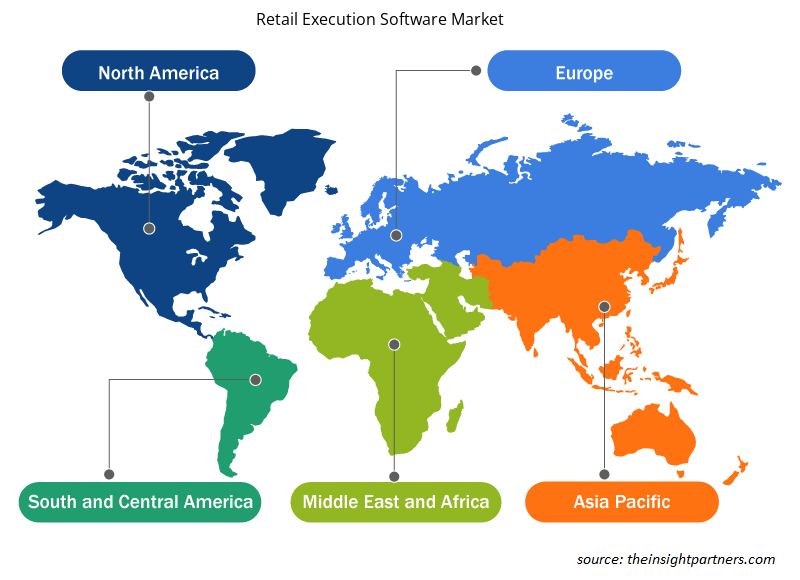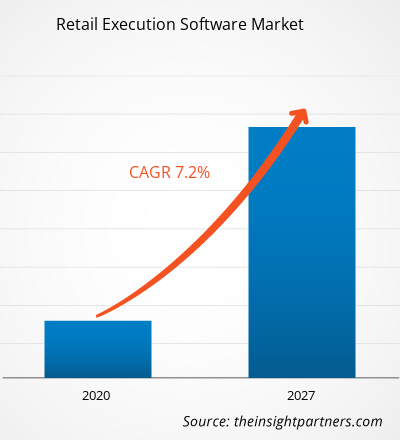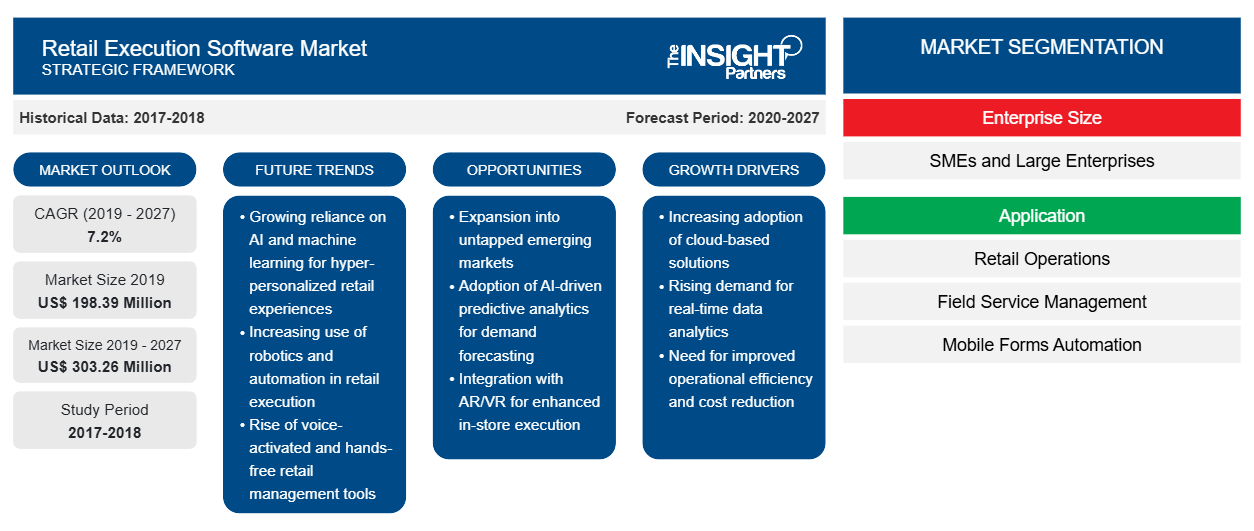Le marché des logiciels d'exécution de détail a été évalué à 198,39 millions de dollars américains en 2019 et devrait atteindre 303,26 millions de dollars américains d'ici 2027 ; il devrait croître à un TCAC de 7,2 % de 2020 à 2027.
Le marché mondial des logiciels d'exécution de vente au détail connaît une croissance substantielle en raison de la préférence croissante des plateformes de vente au détail et de commerce électronique et de l'intégration croissante des passerelles de paiement avec les logiciels d'exécution de vente au détail. Sur la base de la géographie, l'Amérique du Nord est en tête du marché avec une part de revenus de 31,13 %, suivie de l'Europe et de l'APAC. La présence d'une économie en croissance rapide, l'adoption croissante de la technologie automatisée, la pénétration croissante d'Internet et l'adoption massive de logiciels par les utilisateurs finaux sont parmi les principaux facteurs qui devraient stimuler la croissance du marché des logiciels d'exécution de vente au détail dans ces régions. Le marché des logiciels d'exécution de vente au détail en APAC devrait croître au TCAC le plus élevé au cours de la période de prévision. L'adoption croissante de technologies avancées dans le secteur de la vente au détail stimule le taux d'adoption des logiciels d'exécution de vente au détail. Les entreprises investissent dans des logiciels pour rationaliser leurs opérations commerciales. En APAC, les marchés de la vente au détail et du commerce électronique qui connaissent la croissance la plus rapide sont l'Inde et la Chine. Les consommateurs de ces pays sont très enclins à faire des achats en ligne en raison de la pénétration croissante d'Internet, et les tendances des achats en ligne transforment plusieurs domaines de la vente au détail et du commerce électronique dans la région. Ces facteurs stimulent la croissance du marché des logiciels d’exécution de détail dans la région Asie-Pacifique. D’autres régions en développement, telles que la région Moyen-Orient et Afrique et la région Asie-Pacifique, devraient également connaître une croissance soutenue en raison des initiatives gouvernementales croissantes visant à numériser l’économie grâce à l’adoption de technologies avancées.
Personnalisez ce rapport en fonction de vos besoins
Vous bénéficierez d'une personnalisation gratuite de n'importe quel rapport, y compris de certaines parties de ce rapport, d'une analyse au niveau des pays, d'un pack de données Excel, ainsi que d'offres et de remises exceptionnelles pour les start-ups et les universités.
-
Obtenez les principales tendances clés du marché de ce rapport.Cet échantillon GRATUIT comprendra une analyse de données, allant des tendances du marché aux estimations et prévisions.
Impact de la pandémie de COVID-19 sur le marché des logiciels d'exécution de vente au détail
Selon le dernier rapport de l’Organisation mondiale de la santé (OMS), les États-Unis, l’Espagne, l’Italie, la France, l’Allemagne, le Royaume-Uni, la Russie, la Turquie, le Brésil, l’Iran et la Chine figurent parmi les pays les plus touchés par l’épidémie de COVID-19. La crise affecte négativement les industries du monde entier. L’économie mondiale a été la plus durement touchée en 2020, et il est probable que cela continue également en 2021. L’épidémie a créé des perturbations importantes dans les secteurs primaires tels que la logistique, la vente au détail et le commerce électronique. Le fort déclin du secteur de la logistique internationale freine la croissance du marché mondial des logiciels d’exécution de vente au détail.
Aperçu du marché des logiciels d'exécution de vente au détail
Intégration croissante des passerelles de paiement avec les logiciels d'exécution de vente au détail
Stimule la croissance du marché des logiciels d'exécution de vente au détail
Les paiements en ligne sont relativement populaires dans la région Asie-Pacifique, car la plupart des consommateurs utilisent des téléphones portables pour payer leurs achats. Plusieurs options de paiement électronique populaires sont utilisées pour les achats numériques mobiles dans des pays tels que la Corée du Sud, le Japon, Singapour et l'Australie. Les sociétés de passerelles de paiement de ces pays proposent des solutions de paiement électronique complètes à divers fournisseurs de logiciels d'exécution de vente au détail afin de profiter de la vague du développement technologique. En outre, la croissance du marché est attribuée aux progrès de la technologie des passerelles de paiement et à l'augmentation de l'utilisation des portefeuilles mobiles. L'intégration croissante des systèmes de passerelle de paiement avec les logiciels d'exécution de vente au détail et l'augmentation des achats en ligne, ainsi que les progrès des méthodes de facturation, devraient encore alimenter la demande de logiciels d'exécution de vente au détail au cours de la période de prévision.
Informations sur le marché en fonction de la taille de l'entreprise
En fonction de la taille de l'entreprise, le marché des logiciels d'exécution de vente au détail est divisé en grandes entreprises et PME. En 2019, le segment des grandes entreprises représentait une part importante du marché. Cependant, le segment des PME devrait enregistrer un TCAC important au cours de la période de prévision.
Informations sur le marché basées sur les applications
En fonction des applications, le marché des logiciels d'exécution de vente au détail est segmenté en opérations de vente au détail, gestion des services sur le terrain, automatisation des formulaires mobiles, ventes sur le terrain, gestion des promotions commerciales, engagement des employés, etc. En 2019, le segment des opérations de vente au détail représentait une part importante du marché. Les opérations de vente au détail impliquent la gestion des individus, de la chaîne d'approvisionnement, de l'agencement des magasins, des opérations de caisse, de l'inventaire physique et de la gestion des données de base, des promotions et des prix. Les logiciels d'exécution de vente au détail pour les opérations de vente au détail équipent les magasins de détail physiques d'outils pour tirer parti de leurs informations actuelles et les exploiter d'une manière qui profite à leur entreprise.
Les entreprises sont très engagées dans le développement de nouveaux produits pour gagner du terrain sur le marché des logiciels d'exécution de vente au détail. Par exemple, Salesforce a lancé un nouveau produit sectoriel, à savoir Consumer Goods Cloud, qui permet aux entreprises de biens de consommation de stimuler la croissance de leurs revenus et d'augmenter leur retour sur investissement grâce à des capacités d'exécution de vente au détail améliorées. Quelques développements réalisés par des acteurs clés sont répertoriés ci-dessous :
2020 : StayinFront, Inc. Retail Data Insight (RDI) a étendu son partenariat avec Field Sales Solutions pour des analyses en temps réel. La vue terrain et la vue ROI de StayinFront RDI fournissent des informations exploitables aux équipes de vente sur le terrain. Les services facilitent et maximisent l'efficacité en magasin, permettant aux clients de Field Sales Solutions de faire plus, d'en savoir plus et de vendre plus.
2018 : Intelligence Retail a contacté IBM pour améliorer son offre principale et permettre à ses clients de profiter du suivi des indicateurs clés d'audit des magasins en temps réel. Un nouveau module analytique de la solution Intelligence Retail, basé sur les technologies IBM Watson Analytics intégrées, est conçu pour aider à suivre efficacement les indicateurs clés de l'audit de vente au détail en traitant en temps réel les big data, notamment la disponibilité des produits en rayon, la part de rayon, les prix et les promotions
Aperçu régional du marché des logiciels d'exécution de vente au détail
Les tendances et facteurs régionaux influençant le marché des logiciels d’exécution de vente au détail tout au long de la période de prévision ont été expliqués en détail par les analystes d’Insight Partners. Cette section traite également des segments et de la géographie du marché des logiciels d’exécution de vente au détail en Amérique du Nord, en Europe, en Asie-Pacifique, au Moyen-Orient et en Afrique, ainsi qu’en Amérique du Sud et en Amérique centrale.

- Obtenez les données régionales spécifiques au marché des logiciels d'exécution de vente au détail
Portée du rapport sur le marché des logiciels d'exécution de vente au détail
| Attribut de rapport | Détails |
|---|---|
| Taille du marché en 2019 | 198,39 millions de dollars américains |
| Taille du marché d'ici 2027 | 303,26 millions de dollars américains |
| Taux de croissance annuel composé mondial (2019-2027) | 7,2% |
| Données historiques | 2017-2018 |
| Période de prévision | 2020-2027 |
| Segments couverts |
Par taille d'entreprise
|
| Régions et pays couverts |
Amérique du Nord
|
| Leaders du marché et profils d'entreprises clés |
|
Densité des acteurs du marché des logiciels d'exécution de vente au détail : comprendre son impact sur la dynamique commerciale
Le marché des logiciels d'exécution de vente au détail connaît une croissance rapide, tirée par la demande croissante des utilisateurs finaux en raison de facteurs tels que l'évolution des préférences des consommateurs, les avancées technologiques et une plus grande sensibilisation aux avantages du produit. À mesure que la demande augmente, les entreprises élargissent leurs offres, innovent pour répondre aux besoins des consommateurs et capitalisent sur les tendances émergentes, ce qui alimente davantage la croissance du marché.
La densité des acteurs du marché fait référence à la répartition des entreprises ou des sociétés opérant sur un marché ou un secteur particulier. Elle indique le nombre de concurrents (acteurs du marché) présents sur un marché donné par rapport à sa taille ou à sa valeur marchande totale.
Les principales entreprises opérant sur le marché des logiciels d'exécution de vente au détail sont :
- Bizom (Mobisy Technologies Private Limited)
- EdgeCG (StayinFront, Inc.),
- Vente au détail intelligente
- Mobisoft
- Sonde POP
Avis de non-responsabilité : les sociétés répertoriées ci-dessus ne sont pas classées dans un ordre particulier.

- Obtenez un aperçu des principaux acteurs du marché des logiciels d'exécution de vente au détail
Par taille d'entreprise
- Grandes entreprises
- PME
Par application
- Opérations de vente au détail
- Gestion des services sur le terrain
- Automatisation des formulaires mobiles
- Ventes sur le terrain
- Gestion de la promotion commerciale
- Engagement des employés
- Autres
Par géographie
-
Amérique du Nord
- NOUS
- Canada
- Mexique
-
Europe
- France
- Allemagne
- Italie
- ROYAUME-UNI
- Russie
- Reste de l'Europe
-
Asie-Pacifique (APAC)
- Chine
- Inde
- Corée du Sud
- Japon
- Australie
- Reste de l'APAC
-
Moyen-Orient et Afrique (MEA)
- Afrique du Sud
- Arabie Saoudite
- Émirats arabes unis
- Reste de la MEA
-
Amérique du Sud (SAM)
- Brésil
- Argentine
- Reste de SAM
Profils d'entreprise
- Bizom (Mobisy Technologies Private Limited)
- EdgeCG (StayinFront, Inc.)
- Vente au détail intelligente
- Mobisoft
- Sonde POP
- Solutions mobiles Spring, Inc.
- Trax Technology Solutions Pte Ltd.
- Valomnie
- GAGNEZ
- Groupe Kantar
- Analyse historique (2 ans), année de base, prévision (7 ans) avec TCAC
- Analyse PEST et SWOT
- Taille du marché Valeur / Volume - Mondial, Régional, Pays
- Industrie et paysage concurrentiel
- Ensemble de données Excel
Rapports récents
Rapports connexes
Témoignages
Raison d'acheter
- Prise de décision éclairée
- Compréhension de la dynamique du marché
- Analyse concurrentielle
- Connaissances clients
- Prévisions de marché
- Atténuation des risques
- Planification stratégique
- Justification des investissements
- Identification des marchés émergents
- Amélioration des stratégies marketing
- Amélioration de l'efficacité opérationnelle
- Alignement sur les tendances réglementaires























 Obtenez un échantillon gratuit pour - Marché des logiciels d'exécution de vente au détail
Obtenez un échantillon gratuit pour - Marché des logiciels d'exécution de vente au détail